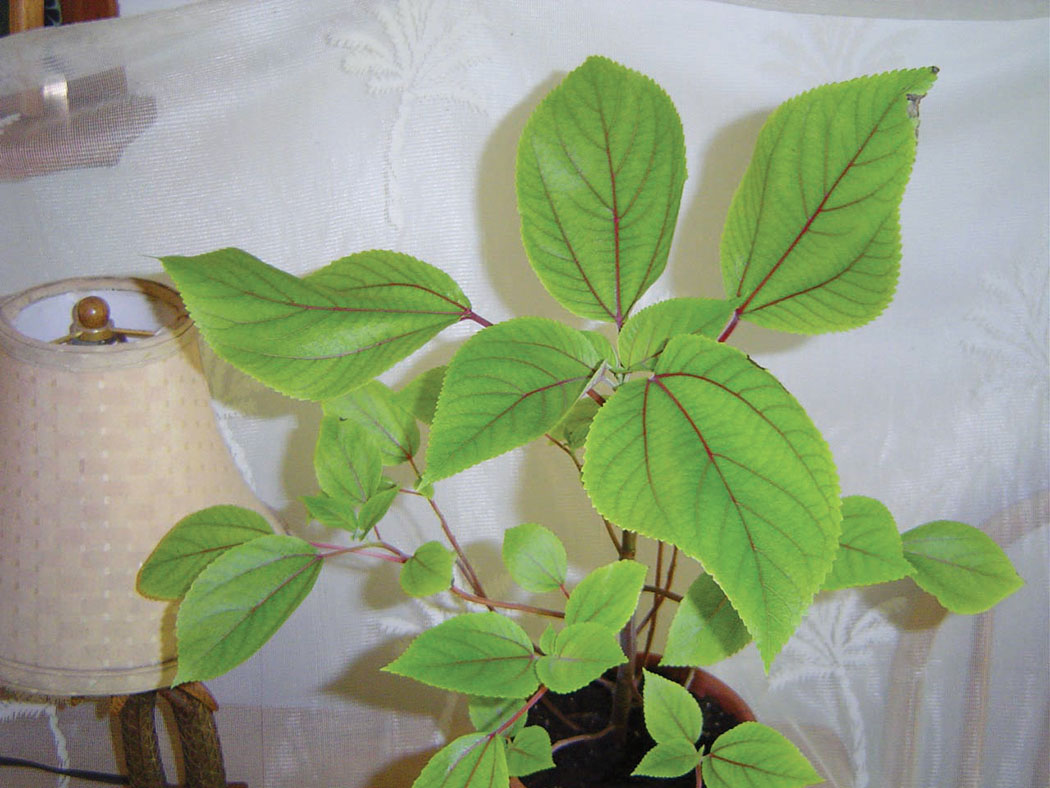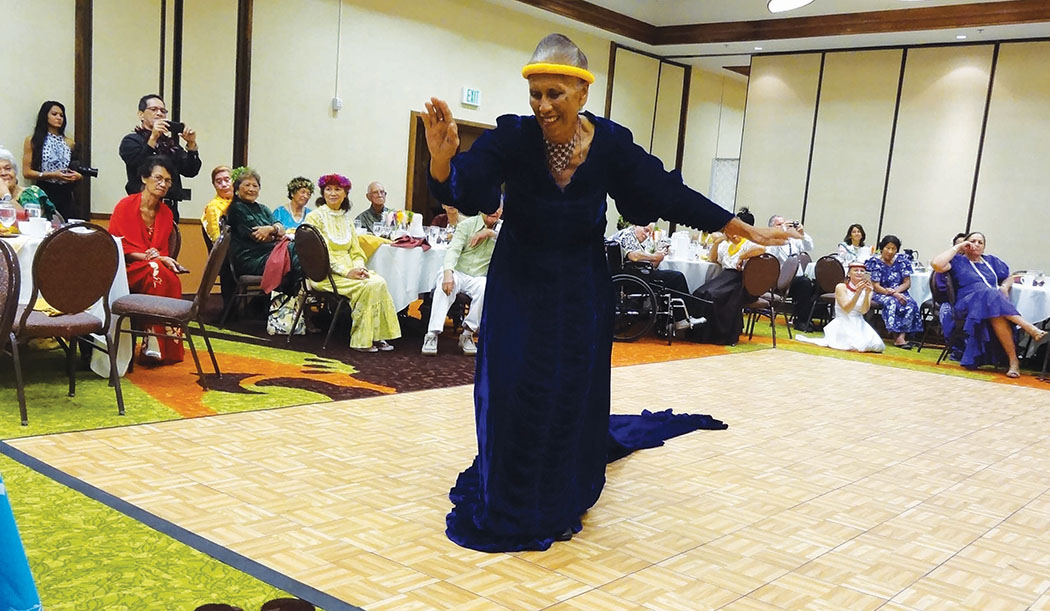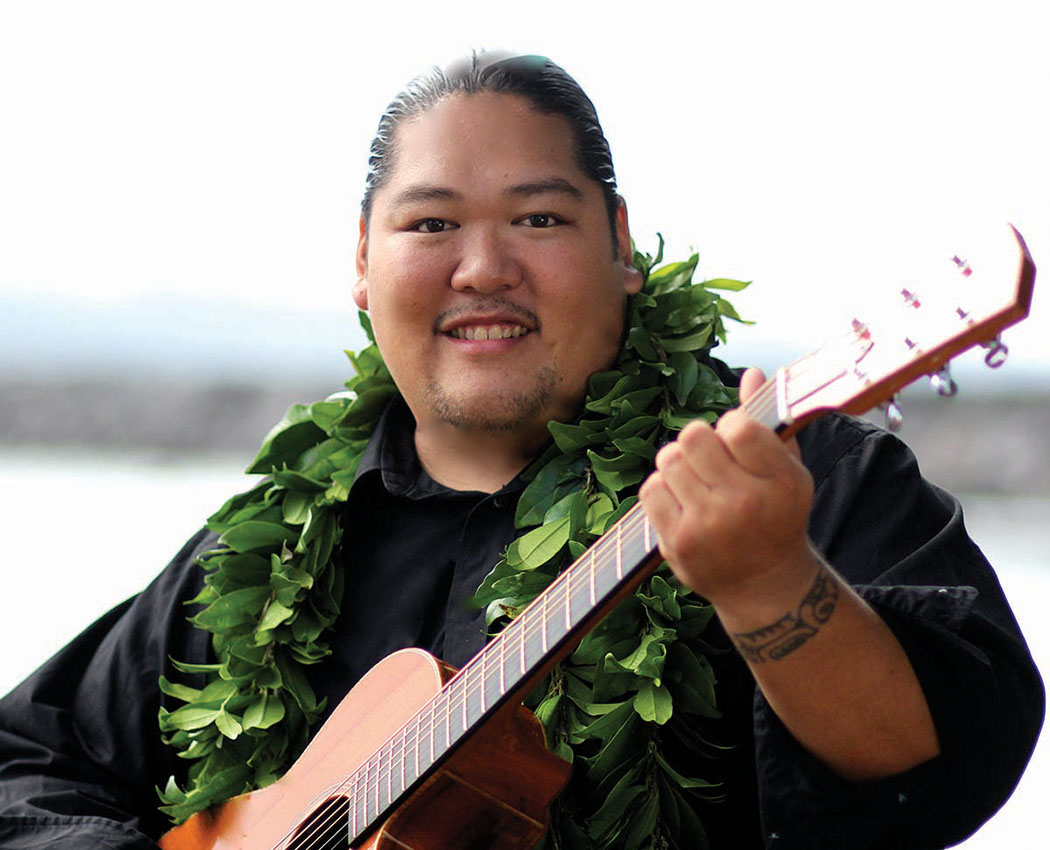
Fire and Ice: Kumu Dane Kaohelani Silva’s Life of Spirit and Service to Health
 By David Bruce Leonard, L.Ac.
By David Bruce Leonard, L.Ac.
As the late afternoon sun warmed his back and shoulders, the chiropractor, acupuncturist, and teacher of Long Life Lomilomi walked briskly across his garden, following a well-worn path between tall ‘ōhi‘a trees bedecked with scarlet lehua flowers. Kumu Dane Kaohelani Silva paused as he heard a high-pitched humming sound from behind him. He turned to identify the source of the vibration.
Hmm…no one there. With his curiosity piqued, and no immediate source of the sound apparent, he resumed his daily walk. Once more, the humming sound caught his attention, and he stopped and turned completely around to see what was making the vibration. At that moment, a ray of sunlight reflected off the yellow flowers of the low bush alongside the trail. Dropping to one knee, he examined the cluster of flowers and noted that their usual color had deepened to a beautiful, golden hue.
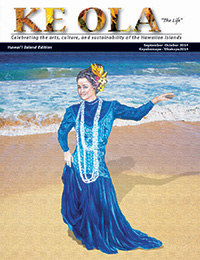
Kumu wondered if this small flower could be the source of the humming sound.
It was.
He had heard stories like this from his kūpuna, growing up in Keaukaha on Hawai‘i Island. But this was first hand, personal, and visceral. He knew intuitively that this plant was calling to him. It was a hō‘ailona, or omen.
Heeding the request from the flowers, a stunned kumu offered a prayer of purification and blessing for the garden, formally asking permission from the plant to use it as medicine. He followed his formal protocol for gathering, storing, and drying the plants under the shade of the deck at his small studio amidst the ‘ōhi‘a trees. A few weeks later, simply following his instincts, he prepared the flowers and leaves for heating in a large pot of coconut oil. After soaking the lā‘au (medicines) in the oil for an additional day, he separated the plant matter and poured the filtered oil into containers that he stored in the refrigerator.
How would he use it? As he thought about it, he knew that some use would appear for the mysterious plant.
His faith and trust in his intuition was strong, but it had not always been that way. This trust in his deep inner knowing was a gift from his kūpuna; it was a seed that had been nurtured in him through the years and the powerful experiences he’d had with his teachers.
Growing up in the tough neighborhood of Keaukaha was not an easy task for this bright and intensely curious young man. There was often little food to eat and even less education. In order to survive the chaos and aggression around him, he initially remained passive and avoided confrontation.
That didn’t work, and only increased the stress of living in the small community.

Sensing that this bright young man was on a troubled path, a local elder named Uncle Bill Kanui took Dane under his wing and began to teach him martial arts, healing, and Hawaiian culture. Uncle Bill trained Dane in everything from working with energy to instructions on how to catch and prepare fish for dinner. Uncle’s large family gym became Kumu’s second home. The young man’s spirit began to flourish.
As Kumu recalls, “Uncle Bill taught me to be receptive to my immediate environment and to increase my awareness as a tool for survival and self-mastery.”
Once, when Kumu was walking to Uncle Bill’s house, he saw that a neighbor’s garage had collapsed. No one had a clue that there was anyone in there, but Kumu sensed a body under the rubble. He called on two of Uncle Bills’ sons to help him start digging. Sure enough, they dug up a young boy. He had no breath and no pulse. Kumu performed the techniques he had learned from Uncle Bill. At first the heart began to beat again, then the breathing resumed.
In 1959, Kumu began to study herbal medicine with Uncle Henry Auwae, and his lifelong fascination with plant medicine began.
Stoking the Fire

After graduating from high school, he left Hawai‘i to study engineering and science at Purdue University on the mainland. One day, while studying chemistry in the college cafeteria, he was to have the first of many inexplicable experiences: inner “voices.” These voices would prove to have a powerful influence on his life, allowing him to observe and understand things that were not readily apparent. These experiences would eventually propel him even deeper into the myths, legends, and nuances of Hawaiian culture.
In the Purdue cafeteria, as he passed by a young woman, he sensed a yearning for “help” coming from her, although she was not looking at him or acknowledging him in any way. He found himself walking up to the young woman, holding her hand, and looking into her eyes. When he did, she told him she had been in a lot of pain and had been hoping that someone would do that.
“How is it possible to hear someone else’s thoughts?” he wondered.
This was the beginning of Kumu’s realization that we must be able to use both sides of our brain including our body awareness and intuition if we are going to be effective as human beings. This was a tradition that was deeply embedded in Hawaiian culture, and it resonated with him.
This experience was such a turning point for him that he left college and returned to Hilo to study meditation, ceremonies, and hula with Kahu Lanakila Brandt. Kahu Lanakila also introduced Dane to Ho‘oponopono, the Hawaiian ritual tradition for healing.
Dane had not yet turned 25 years old, when he left a college career in science to completely immerse himself in the culture of his people.
As he got in touch with the spiritual side of healing, it deepened his awareness of both the mysteries inherent in our humanness, and the profound tools provided by his ancestors.
Later, while still immersed in Hawaiian cultural studies, Dane heard another inner voice, this one telling him to complete his degree. Not having any idea exactly what that “degree” might be, he drove to UH Hilo. As he was stepping out of his van, an old school friend called out to him, “Are you Dane Silva? Come on up and meet Dr. Sood.”
Dr. Sood, it turns out, had an NIH grant to study cancer. He took the bright young student under his guidance and asked Dane to be a Minority Biomed Research Student (MBRS) to study electron microscopy and tissue cultures of various cells.
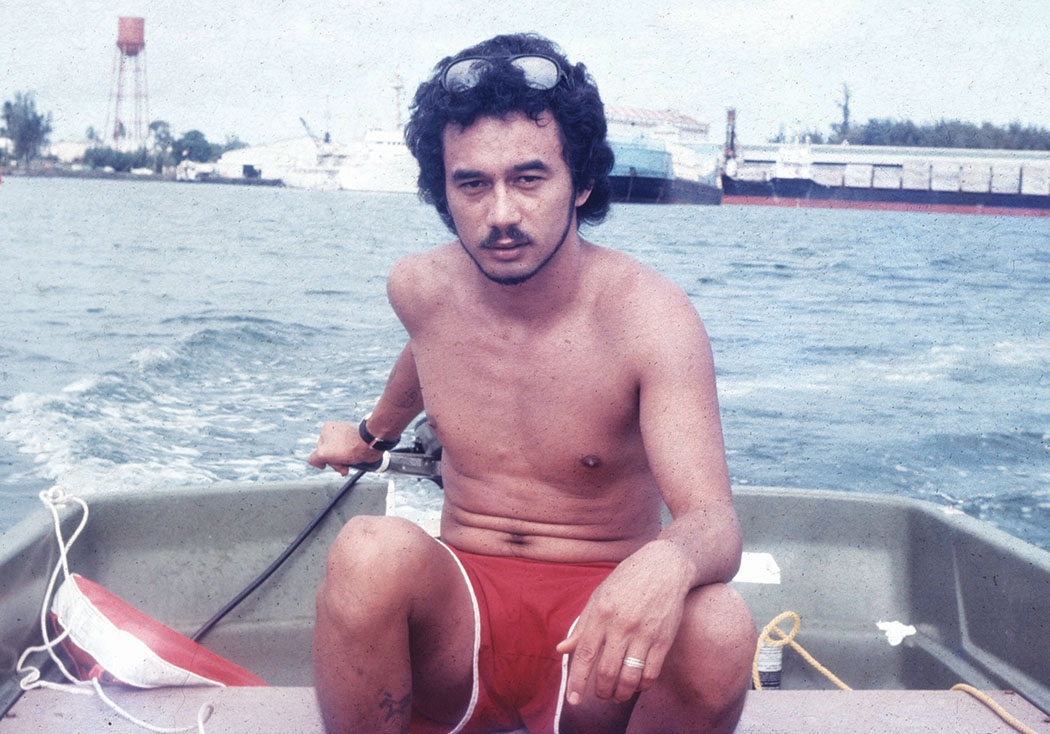
And study he did, learning the specific details and nuances of statistical analysis and the many sophisticated protocols of Western medical scientific research.
One day he got a call in the lab asking him to teach science in the local nursing school. This was 1976 and the beginning of his career in vocational education.
While in college, he was disturbed to find that the numerous sports injuries he had acquired over the years were not healing. Disillusioned with the way Western medicine was treating his conditions, he began to explore other modalities for treating his ailments. Pleasantly surprised, he discovered that injuries that had not responded to Western medical treatment at all were completely resolved by massage, acupuncture, tai chi, herbs, and meditation.
His awareness of the need to combine scientific and cultural medicines began to grow. He realized that the great gifts that have been given by his ancestors have been overlooked in Hawai‘i. Their effectiveness has been systematically minimized by modern corporate medicine.
As his clinical and research skills increased, Kumu began to build a philosophical foundation for a truly integrated system of medicine. In the 1990s, he was asked to provide technical support for a research study that described chronic inflammation as the central axis or common ground for a number of neuromusculoskeletal disorders. This was an idea that was way before its time.
In Kumu Dane’s Words
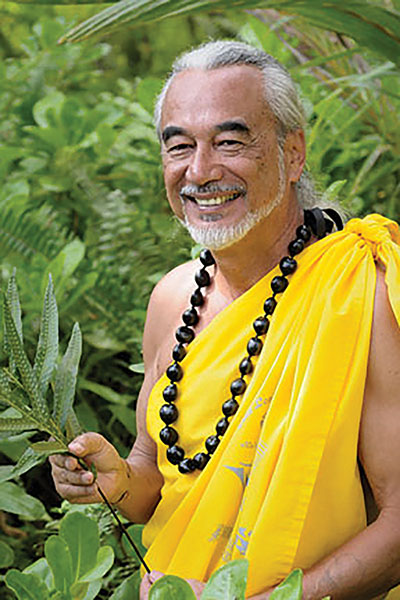 “This prompted me to conduct further studies of my own into the impact of chronic inflammation on these and other health disorders. I realized that inflammation was at the center of many of the ailments of the Hawaiian people. It was a common factor in heart, lung, kidney diseases, liver and pancreatic disorders, cancers, infections and autoimmune disorders.
“This prompted me to conduct further studies of my own into the impact of chronic inflammation on these and other health disorders. I realized that inflammation was at the center of many of the ailments of the Hawaiian people. It was a common factor in heart, lung, kidney diseases, liver and pancreatic disorders, cancers, infections and autoimmune disorders.
“In describing the situation, I referred to inflammation as Fire, and the subsequent traditional anti-inflammatory treatments as Ice.
“At the start of my voyage of discovery, it was very difficult to find appropriate studies that fit my search profiles. But things have changed radically in the past few years, and the numbers of congruent studies have increased dramatically.
“I began to speak at medical conferences about my findings. At first, the ideas were novel yet well accepted by biomedical educators, researchers, and physicians on the continent. Here on my own home grounds in Hawai‘i nei, some local Hawaiian physicians rejected my thesis and publicly rebuked me. I considered their criticisms seriously and dove deeper into my search for truth. At this point in time, I can safely say with confidence that my thesis has been accepted and acknowledged by the mainstream authorities at the national and international levels.
“It has still been an uphill struggle, however, to address this topic with leaders of the health care systems in Hawai‘i. Saddled with the rising tide of obesity and diabetes, complicated by high blood pressure, heart attacks, kidney failure, and cancer within their own families, the powers that be are desperately looking for answers solely within scientific medicine.
“Sadly, I don’t expect any miracles there. It didn’t work before, and employing the same methodology cannot be expected to produce different results in the future.

“Historically, we Hawaiians have known this all along from our direct perception and vast experience in healing our own people. We can see very clearly with our own eyes when one of our treatments makes people better. We do not need a scientific study to validate what we already know: that Hawaiian medicines save Hawaiian lives. In the past we have been forbidden to speak our own language and practice our own healing arts. Our traditional healers have been politically suppressed and punished, and it is still happening today within our current system. Our people are suffering, and our young people are getting sicker. Scientific medicine has not effectively addressed our healthcare needs. Kānaka Maoli (Native Hawaiians) cannot readily access our traditional healthcare. Where is our traditional Hawaiian medical school? So much money continues to be spent on what has already failed.
“Hawaiians need Hawaiian medicines. Western corporate medicine needs to recognize the profound value of our traditional practices. Our Native Hawaiian healthcare system desperately needs a new direction: Lōkahi. Lōkahi is the physical, spiritual, and emotional treatment of the whole person in an integrated medical system. And we need this integration to be more than just corporate lip service; it has to emerge from the ground up. Traditional healers should be hiring the doctors and nurses, not the other way around. If we ask an engineer to design a healing center, we are going to get a prison, not a place of true healing.”
Happy Trails
And what ever became of the plant oil he made?
Kumu indeed found a use for it. He has used it on numerous diabetic neuropathies with promising results.
Kumu Dane Kaohelani Silva’s inner voices, those provided by his ancestors and cultivated by his teachers, once again have directed him on the powerful path of spirit and service. ❖
Contact Kumu Dane Silva: HaleOla.com
Contact writer David Bruce Leonard L.Ac.: EarthMedicineInstitute.com
